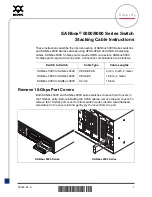
Market Central, Inc.
R1000 NBS/NAC
Page 3 of 16
2. Introduction
The R1000 Network Backup Switch and Network Access Controller connect port A or port B to COMMON,
through latching relays (in the case of the R1000-NAC models, the connection is more appropriately designated ON
or OFF, as they are 2 port switches, COMMON to port B (ON) Common to port A (OFF). Since the relays are
latching, the state of connections will be maintained with power off.
For RJ45 models, pins 1, 2, 3 and 6 are switched, which are the standard 10/100base-T Ethernet signal locations on
an RJ45 connector. While the R1000 is primarily intended to switch Ethernet, it can be used for any electronic
signal switching, if the signals are passed through the supported pins. The relays are transparent to data rates, signal
levels and format. The RJ45 models are available in 8 and 16 port versions.
Fiber optic models are also latching, and use precision optical mirror mechanisms to switch connections and are thus
completely transparent to rates, protocols, and wavelengths. The fiber optic models are available in 4 and 6 port, ST
and SC duplex versions.
Manual gang control of all ports is available through a momentary toggle switch on the front of the unit, enabled by
a removable key lock. Serial RS232 control can gang or individually switch ports, as well as mo nitor switch status.
An Ethernet port (10base-T) on network manageable models allows remote control and monitoring using TCP/IP.
The R1000 models are housed in a steel desktop chassis, with provisions for 19” rack mount (brackets supplied).
3. Configuration
There are no user configurable settings on the R1000 models for basic operation. There are some parameters related
to TCP/IP operations which are accessed through the serial RS232 port, which are required to communicate to the
unit over Ethernet. These settings are described later in this manual.
The internal jumpers and DIP switches inside the R1000 have been pre-configured at the factory and should not be
changed from their default settings. They are shown here for reference only.
jumper W1
1-2 position = no SNMP module, serial RS232 only
2-3 position = SNMP module installed, Ethernet & serial RS232
jumper W2
1-2 position = no SNMP module, serial RS232 only
2-3 position = SNMP module installed, Ethernet & serial RS232
DIP SW1
positions 1 & 2 OFF, and positions 3 & 4 ON to limit to < 4 port operation
positions 1 & 3 OFF, and positions 2 & 4 ON to limit to < 6 port operation
positions 1, 2 & 3 OFF, and position 4 ON to limit to < 8 port operation
positions 1 – 4 all OFF to limit to < 16 port operation
position 5 OFF = SNMP module installed, position 5 ON = RS232 only
position 6 OFF = non-latching fiber optic modules, position 6 ON = latching foms or relays
position 7 OFF = non-latching relays, position 7 ON = latching relays
position 8 OFF (reserved for future use)
DIP SW2
positions 1-8 ON (reserved for future use)
4. Installation
1.
Find a location suitable for installing the R1000 chassis, with access to AC power outlets and the
connections you intend to switch through the unit.
2.
If you intend to use serial control, connect a serial cable to the DB9 RS232 console port, the baud rate is
fixed at 9600 baud, no parity, 8 data bits, and 1 stop. See figure 1 for connector signal assignment.


































